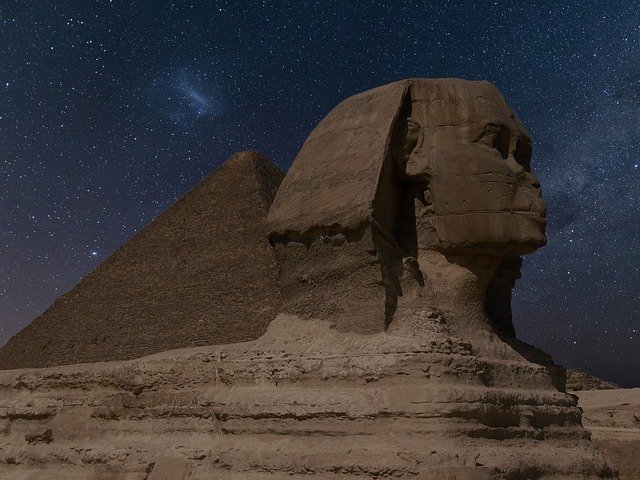Is there really Evidence of Civilizations predating our Recorded History?
The early civilizations
I have yet to visit Egypt and have never been to any of the Mayan temples, but I have always been fascinated by whom these people were and how did they build such amazing structures. It seems all too much for one generation to build.
How did they move such large objects to locations many miles away from their original quarry? How did they perform such remarkable carvings with only soft bronze or copper tools to work with?
We give credit to the early Egyptians and the Indus-Harrapa civilization with strong mathematical skill, but the first written evidence of advanced arithmetic dates from Sumeria, where 4500-year-old clay tablets show multiplication and division problems.
So were the Egyptians of the Old Kingdom the most advanced, or did they just learn what previous civilizations taught them?

Sphinx and Pyramid image Pete Linforth
Questions regarding the age of the Great Sphinx
The image of the Sphinx is a very interesting problem. Why would someone want a large body of a lion and a small head of a pharaoh? Could it have been simply a case of the Egyptians taking a statue that already existed and modifying it? For thousands of years, sand buried the colossus up to its shoulders, creating a vast disembodied head atop the eastern edge of the Sahara.
Around 1400 BC, Thutmose IV partially unearthed the lower portion of the great statue and attempted to protect it with stone encasements.
The head of the Sphinx appears to be much newer and its size is significantly disproportionate to the body of the statue. In Thutmose’s time, he describes lying against the head as it is the only thing visible, all else buried under the drifting sands.
If a Pharaoh decided to have his face immortally present, it is a perfect opportunity to reconstruct the face while it is so close to the surface. Was it still buried in the time of Pharaoh Khafre? Was it just a ruin from a previous epoch and the ancient Egyptians wanted to put their mark on it?
The Sphinx has undergone several attempts at restoration or protection, but it has been subject to the shifting sands of the Sahara. In 1817, a Genoese adventurer, Capt. Giovanni Battista Caviglia led the first modern attempt to dig out the Sphinx.
Again, the sand prevented the full recovery. Finally, in 1931, the Sphinx was fully excavated. With that excavation, we see the full body of the Sphinx and the wind and water erosion on the quarry around the sculpture and on the body of the Sphinx.
The most common wisdom holds that the monolith is around 4,500 years old and the human head is that of Pharaoh Khafre. If the Sphinx was built by Khafre, why are there water erosion marks all over the body of the Sphinx and not the head? The Sahara is a parched environment and has been that way since the times of the Pharaohs.
Forensic investigation of a known statue of Khafre and the head of the Sphinx shows significant differences and concludes that this is not a statue of Khafre.
In this video, Graham Hancock presents multiple avenues of argument that the Sphinx is not the image of Khafre, including a comparison by a forensic artist from the New York Police Department.
How could Egypt have been tropical
If it is not Khafre, who is it? More importantly, when was it carved?
Famed Egyptologist Mark Lehner has studied the Sphinx for many years and readily admits that the Sphinx must have originally been carved when Egypt had a much wetter climate.
40 million years ago, the African tectonic plate was moving northward with the Tethys Sea separating it from the European continent. 20 million years ago, it started to isolate the Tethys Sea and began to form the basis that all the material for the Sphinx and the Great Pyramids were made from.
But core drillings in the Atlantic off the western coast of Africa show that sand from the newly formed Sahara desert was first deposited there 3 million years ago, giving an accurate date of the birth of the Sahara. But clues from our modern technology (our satellite images) show the presence of ancient river beds, suggesting that even in the birth of the Sahara, it had rainy periods.
The Discovery Channel produced an in-depth video on the age, formation, and cycles of the great Sahara Desert. Although the A+E Network does not like for me to link the video here, you can watch if you go to their website and watch the video titled; Discovery Channel — When The Sahara Desert Was Green.
Instead, I offer another equally great video produced by PBS-Eons.
.
.
Some rivers were from freshwater lakes. Scientists have found the beds of freshwater lakes as old as 90,000 years old. It turns out that the Sahara has a dry/wet period of 20,000 years and the last time it was wet was 7,000 ago. Evidence of a settled human community next to a dry lake bed, deep in the Sahara dating to 10-6,000 years ago.
More analysis of the ocean core shows the latest drying of the Sahara was 5,500 years ago and the transition period occurred within 200 years.
So, if it exposed the Sphinx to wet climates, it had to have been built 1000 years or more before the currently accepted date.
A book with controversial opinions
In this discussion, Mr. Hancock, and Robert Bauval collaborate to present a hard-hitting expose on the incorrect dating of the Sphinx, the Pyramids, and other monuments in Egypt, and that these and other artifacts are far older than the established Egyptologists care to acknowledge.
.
.
Summary and Conclusion:
I have presented a hypothesis that the Sphinx is older than currently espoused by mainstream Egyptologists based on weathering on the lower parts of the monument. I have offered videos and links to others who hold this same belief, and I have presented a video that documents when the last time the Sahara was wet enough to have caused this weathering.
I am convinced that the Sphinx is much older than the ancient Egyptians and, in fact, is many thousands of years older. If you care to read a follow-up post of mine that delves deeper into this mystery, please go to Part 2 of this discussion.
Before you leave, you might like to visit Recommendations. This is a special page I made for you with a collection of things I hope you will find interesting.
Photo Source: Pixabay
You can also find more unusual information at the link below.
Photo Source: Pixabay










Comments
GabrielGrey
Hello, I hope you are doing great. This was an awesome read!!
The Sphinx has always fascinated me, as it just seems so different and out of place, really makes you stop and wonder what it;s real purpose was.
The search for ancient civilizations is one that intrigues me quite often, and I as well am a fan of Graham Hancock’s work, he has such an intelligent approach to things.
Thanks for the great information!
Taetske
Good Morning Gabriel,
Our Mother Earth is a treasure trove, so many exciting things still to discover. When I was a small girl I was reading books like The lost island of Mu and Thor Heyerdahl’s Aku Aku. The more one reads the more one realizes that 1 life is definitely too short. I am sure that many unknown civilizations excisted on our planet, what we have discovered up till now is only the tip of the iceberg.Thank you for reading my post.
Regards, Taetske
Brandon
The buildings and ancient structures in Egypt have always been a fascinating topic for me. Just how did these people with the such limited tools and technology create such massive structures and with some insight, in todays world, about what they were built for or used or even why and how.
I have no doubt that the desserts were once beautiful jungles and oasis’. I could go on about the lost city of Atlantis and it’s possible location being in the dessert of Africa (but that is for another time!)
Taetske
Good evening Brandon,
Thank you for leaving a comment on my website. All this is fascinating indeed. Perhaps you care to also read the 3 following posts on this subject.
A shame you did not continue about Atlantis, that is an other favorite I have.
Thank you for your visit, all the best.
Regards, Taetske
Tiffany Domena
Hi Taetske! I think the mysteries of Egypt and the middle east have fascinated people for a long time. There are many spiritual influences there, and most people know there is some merging of dimensions: between the physical and spiritual worlds that have created what we see there. There’s so many theories to sort thru though. How do you know which to stick with? What books do you reference to uncover these mysteries in question?
Taetske
Good Morning Tiffany,
Sorry for being a bit late with answering your comment on my post, I had to get the things together first.
Sources of my inspiration;
Years of disbelief that the face on the Sphinx (with no signs of wind or water erosion) is the original face of the Sphinx.Documentation of wet and dry periods of the Sahara along with proof that the latest wet period ended about 6,000 years ago.Videos (YouTube is a great source if you filter out the BS.) that document that the erosion on the walls surrounding the Sphinx took thousands of years of water erosion to produce what is there today and realizing that the Sphinx was buried by thousands of years of Sahara sand dunes until the 20thBooks I have read.Forbidden Archeology (the Hidden History of the Human Race), by Michael A Cremo and Richard L ThompsonThe Cycle of Cosmic Catastrophes (How a Stone-Age Comet Changed the Course of World Culture), by Richard Firestone, Allen West, and Simon Warwick-SmithFinger-Prints of the Gods, by Graham HancockResearch on Plato’s dialogues discussing Atlantis and learning that Ancient Egyptians knew that many generations earlier, Atlantis actually existed.
Books to readPlato’s Caribbean Atlantis: a Scientific Analysis, by Dr. P Flambas.The Epic of Gilgamesh
I hope this is of some help to you, thank you for your visit.
Regards, Taetske
NSOH ALIEH LAURINE
Egyptologists have been giving different and inconsistent views on the origins of the Sphinx. Is it that they truly don’t about this mysterious statue, or they know something that they are hiding from the whole world? I believe the second scenario to most likely the case.
If the date on which this Sphinx was created is determined, then it would be possible to identify the generation from which this civilization was created. But how can it be that this civilization was not taught to upcoming generations?
I actually have a theory that no one has ever mentioned online. It’s purely speculations but reasonable. If you want to know more, then inbox me using the email address I used on your website.
I enjoyed the read, and especially the video.
Taetske
Here are the links Laurine, talk to you in the near future.
Regards, Taetske
Good afternoon
Thank you for leaving a comment on my post.
I am willing to have a private conversation with you but I would kindly request that you read the 3 following up posts on the subject first. Then please get back to me.
Regards, Taetske
https://motherearthstreasures.com/there-is-controversial-evidence-of-prehistoric-civilizations-pt-2
https://motherearthstreasures.com/there-is-controversial-evidence-of-prehistoric-civilizations-pt-3
https://motherearthstreasures.com/there-is-controversial-evidence-of-prehistoric-civilizations-4th-and-final-pt
Taetske
Good afternoon Laurine, I hope I got your name right?
Thank you for leaving a comment on my post.
I am willing to have a private conversation with you but I would kindly request that you read the 3 following up posts on the subject first. Then please get back to me.
Regards, Taetske
Michel
What an interesting post. I have always been fascinated by everything Egypt and all its mysteries. That is one place I have to visit before I die.
I wonder if the mystery of the Sphinx will ever be fully explained or maybe one day we will be lucky enough to discover the truths we spend our lives seeking.
It is amazing that the head of the Sphinx is not weathered like the body and that is the part that spent most time above ground.
Taetske
Good afternoon Michel,
Thank you for visiting my website and leaving a comment. I hope you downloaded your free PDF?
I am sure many more exciting things will still be discovered in the future. Mother Earth holds many mysteries which have intrigued me for a long time.
Regards, Taetske
Jon
This is an interesting article explaining why the Sphinx is thought to be by you and other scholars older than it first appears or is landmarked to be. I agree it should be protected as I’m sure it means much more than it first appears to the eye. I’m sure other civilizations thought the sphinx to have magical properties.
Taetske
Good afternoon Jon,
Thank you for stopping by and leaving a comment. I hope you downloaded your free PDF?
There are intriguing things in our world and perhaps we will never get an answer. But I hope that scientist will come up with some more information soon.
Regards, Taetske
Anita
Fascinating article, and whether is there is evidence of civilizations predating our recorded history, I don’t if there is evidence but I am sure there is history but it may not be preserved as well. I find all of the histories of Ancient Egypt very interesting. I have often wondered what the Sphinx is supposed to represent. Maybe it was reused as you mentioned, it could have been a base that was covered in sand and they just used it to support another structure since the base was no longer visible.
Taetske
Good afternoon Anita,
Thank you for your comment. I hope you downloaded your free PDF?
I wrote four articles on this subject and they are sequential so you really should visit the other three.
They will give you insight into other civilizations that predate the known Egyptians. The Library of Alexandra was a major loss to us and we are still struggling to understand what we lost.
I believe the Sphinx was re-carved to honor one of the fathers, and I do not think is Khafre. This is in my second article. Why not carve an honored image on a weathered rock in the middle of nowhere. For thousands of years, the body was not fully excavated so no one knew what it was until Thutmose IV started removing the sand from between its forepaws. You will also notice that the head on the Sphinx is proportionally much smaller than the body would suggest
I think you would enjoy reading the other parts of this story.
Regards, Taetske
Andi
The Great Sphinx has always been fascinating to me. I am intrigued by mother earth and all her history. Your website and topics are very informative. From beginning to end there is a great break down for the topic. The videos are great for additional information. I have enjoyed reading through your post. I look forward to reading through more topics.
Taetske
Good afternoon Andi,
Nice to hear you like my posts. I try to publish every week so do come back in the future. Mother Earth is so fascinating and very little has been discovered up till now.
Thank you for leaving a comment on my website. I hope you have downloaded your free PDF?
Regards, Taetske
Jyl
I have to say that I believe in prehistoric civilisations for sure, and I’m pretty sure that they were way more ‘civilised’ that any of us are. But the riddle of the ‘water erosion’ on the body of the Sphinx, surely it’s really sand erosion? We have no idea over how many years the sands raised over the body of the Sphinx to eventually cover it all but the head? And we all know the effect sand-blasting can have on anything. So why wasn’t this erosion simply caused by the rising sand levels and the well-known sand storms of the desert? I too am fascinated by ancient civilisations, and I’d love to go back in time and visit all these places to get a little insight. I particularly want to know the exact methods of building the pyramids…. I’d love to be in on that 🙂
Taetske
Good afternoon Jyl,
I absolutely agree with you about wanting to have a look back machine so I can watch history as it was being made. But without having the ability to view the past, we have to read the present and formulate what happened in the past.
The differences between sand erosion and water erosion are stark. The first thing to consider is that the lower portions of the Sphinx have been covered for most of their life. We know that slow moving sand will not produce the effects you are thinking about, but fast-moving sand can wear away everything. But once the monument was buried, there was no way for a buried monument to be eroded by moving sand.
There are natural walls on three sides of the Sphinx that show the same weathering patterns on the lower sides of the body of the Sphinx. These have a downward wearing pattern. Yes, there are sideways erosion patterns as well, and the ones on the upper part of the body may have been partially eroded by wind.
Those sideways erosion patterns on the lower part of the body are from tidal actions. And the upper portion of the Sphinx shows minimal erosion so all the time the head has spent above the sands has not created the same kind of damage like that on the lower body.
The second video I have on this post gives a very good presentation on how the erosion took place and when. Please watch the entire video titled “How the Sahara Desert was Made.”
Thank you for leaving a comment. I hope you have downloaded your free PDF?
Wealthfather
I liked your article has it holds great information about the past.
It really is a concise and thorough article. I bookmarked it to come back in the future. I have read that there is controversial evidence of prehistoric civilization but not as comprehensive as your article.
Thank you, I learned a lot
Taetske
Good Morning,
Thank you for commenting on my site. Nice to see you again.
Mother Earth holds many mysteries of which we only know a fraction. I am sure more exciting things will be discovered in the future.
Regards, Taetske
jaykaynigltd
Arts always facinate me especially historical artfacts! This is a very complicated yet interesting article. Prehistorical civilization is a great puzle the more you look (read) the more confused you’re because there are so many version of every story you come across however one certain things is that Egypt is always at the center. So I have come to term with the fact that civilization be it historical or whatever starts mainly with Egyptian.
I wish to read more of this from this page.thanks for sharing
Taetske
Good afternoon Jay,
Thank you for your comment. Nice to see you again.
I used to think that the Egyptians were the major driving force of all our history. But the more I read, the more I come to accept that the Sumerians were much more advanced, but they died out before they could pass their knowledge on to the rest of us. The Egyptians have not passed on their knowledge to us so we can’t fault the Sumerians for this failure. There are so many theories about how the pyramids were built and what their function was that we can easily become very confused. I do hope you read more and enjoy the points I bring up.
Regards, Taetske
Nuttanee
I love to learn the updated information about our heritage. I learned in school that Pluto was a planet and now it is not. I have never been to both Egypt and Mexico either.
Oh wow, that is interesting about the head of the Sphinx. The climate part is also another good debate. I agree that the structure and the foundation will be easier to construct when there is humidity. I am still trying to grasp the idea of the green desert, there is definitely a possibility.
I will definitely check out the book. Thanks for sharing a good read.
Taetske
Good afternoon Nuttanee,
Nice to see you again and thank you for your comment. Remember your free PDF, right?
The issue about the moisture and the Sphinx is not really about its construction but that the weather erosion on the
body of the Sphinx is not consistent with the erosion present on the head. Additionally, the erosion patterns on the
body is evidence of heavy rain and flooding, and that could only have happened when the area was much more
tropical and had significant rainfall.
The videos point out that this happened at least 5000 years ago and may happen in another 5-7 millennia from now.
Regards, Taetske
Anastazja
This is a fascinating article. I am wondering, as I read, if the climate changes that may have occurred to the Sahara presently being studied have anything to teach us today. Two hundred years is a very short time for such a drastic change.
When I think about the amazing structures that have been built around the world, I also think of the human toll they have taken. Structures like the Sphinx that would take several years with our modern equipment must have cost many lives over many generations. The beauty, ingenuity and mystery that we admire was a truly amazing feat of mankind’s ability to create.
Taetske
Good afternoon Jim,
Thank you for your visit and for your comment. I hope you downloaded your free PDF? Tulip widget.
I agree that it is amazing to consider the effort to construct the items attributed to the Egyptian dynasties. As I continue my story of discovery in subsequent posts, I find it very hard to believe that the current perception of how
they were built is factual. Given that the tools of that age could not have made some of the cuts we see on the stones around the Pyramids, it makes me think we lost a previously very advanced civilization because of some catastrophe, natural or not.
Regarding your thoughts on what history can teach us in our struggle with the current climate changes, I can only say that the natural changes took more than 5,000 years for ½ of the cycle but we are facing a much faster rate of temperature change than nature normally supplies.
Regards, Taetske